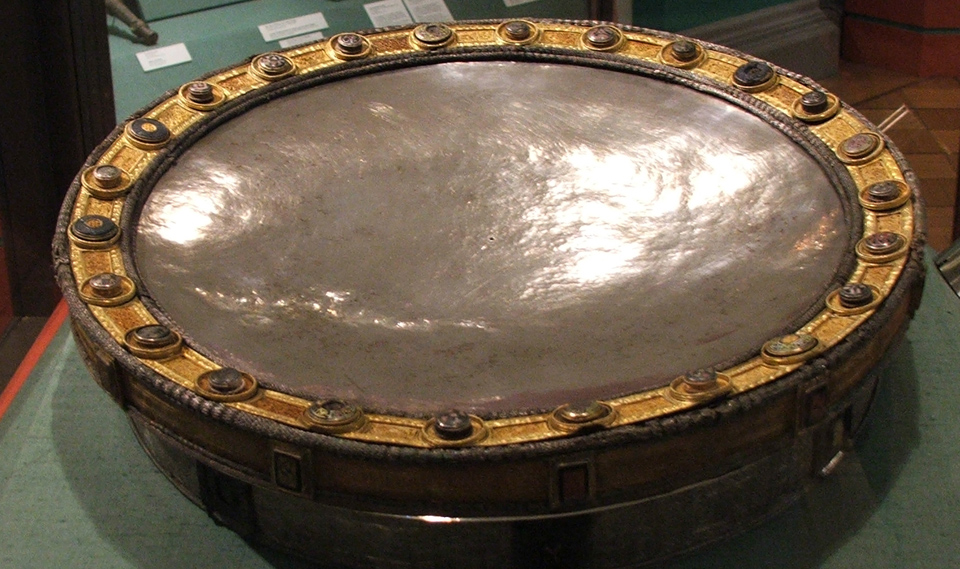On 1st May 1980, 42 years ago today, Michael Webb, a businessman from Clonmel in County Tipperary, announced that he and his son had discovered what became known as the Derrynaflan Chalice on a small island of mineral soil in Littleton bog in Mid-February of that year while they were exploring the ancient monastic site of Derrynaflan with a metal detector.
The Chalice was discovered as part of a hoard of altar vessels, regarded to this day as one of the most spectacular hoard discoveries in Ireland.
The unearthing of the vessels initially led to an increase in enthusiasm for metal detecting as a pastime, but ultimately the discovery was instrumental in the prohibition of unlicensed searching for archaeological material.
While the father and son had the implied permission of the owners of the land on which the ruins stood to visit the site, they did not have the permission to dig on the lands. The father and son kept the discovery a secret for three weeks because a preservation order had been made in respect of the ruin under the National Monuments Act, 1930, making it an offence to injure or interfere with the site.
The Chalice, dating from the 8th or 9th century, was found as part of the Derrynaflan Hoard of five liturgical vessels. The hoard was most likely secreted during the 10th to 12th centuries, when Viking raids and dynastic turmoil meant many treasures were hidden to avert theft. Throughout the early and later 10th century, a particular concentration of hoarding took place in Ireland.
The chalice was discovered with a composite silver paten, a hoop that may have been a stand for the paten, a liturgical strainer and a bronze basin inverted over the other objects. According to art historian Michael Ryan, the hoard “represents the most complex and sumptuous expression of the ecclesiastical art-style of early-medieval Ireland as we know it in its eighth- and ninth-century maturity.”
An excavation was undertaken by staff of the National Museum following the discovery which recovered some missing components of the decorated objects, including die-stamped mounts, rivets and golden filigree panels.
The silver chalice has been compared to the Ardagh Chalice, a chalice used for dispensing Eucharistic wine during the celebration of Mass, one of the greatest treasures of the early Irish Church, found in 1868 by two young local boys digging for potatoes in Ardagh, County Limerick. However, the Derrynaflan Chalice is generally considered to be less elegant, with its decoration simpler, and the filigree not as finely executed. It is also likely slighter later in date than the Ardagh Chalice.
The Derrynaflan Chalice is made of beaten silver that has been lathe-polished. The bowl stem and foot are attached to the bowl by a large pin that locks on a decorated catch-plate on the underside of the foot. There are two handles attached to the bowl that contain recesses into which panels of gold filigree are set into place with stitchind. The handles are decorated with amber studs placed at intervals along the filigree decoration around the bowl of the chalice.
Following the discovery, seven years of litigation unfolded, culminating in legal action at the Supreme Court where the Webbs unsuccessfully sought over £5,000,000 for the find. After the legal action, the Irish Government replaced the Irish laws of being included in the legislation declaring that “there shall stand vested in the State the ownership of any archeological object found in the State after the coming into operation of this section where such object has no known owner at the time when it was found”. The new measures helped to protect archaeological finds in Ireland and to rescue a substantial number of artefacts, many of which added to the corpus of early Irish art.
The discovery also broadened our knowledge of early-medieval European altar plates, and reignited important questions about patronage, craft organisation, wealth, trade, and exchange. The relative significance of the Viking invasions as a disrupting influence on Irish society in the ninth century was brought into focus, as well as the origins of the liturgy practised in the early Irish church.
The finding of the chalice also extended knowledge of the known variety of motifs and decorative techniques, which greatly enriched the understanding of one of the greatest ecclesiastical arts in medieval Europe.

Derrynaflan Paten

Derrynaflan Chalice

Church at Derrynaflan, Co. Tipperary. Photo Credit: Pilgrimage Ireland